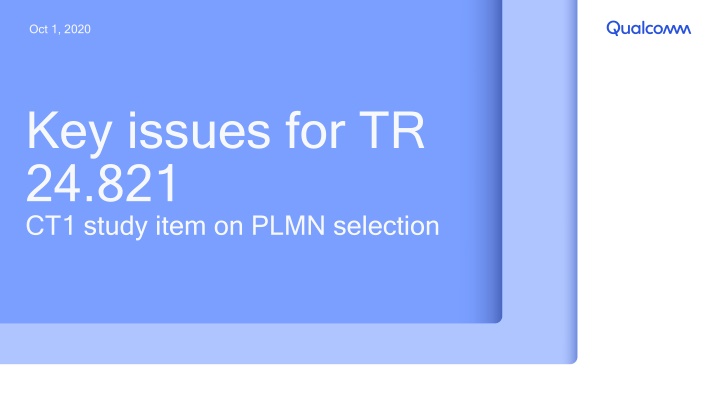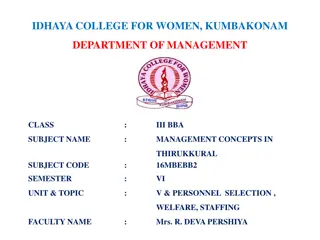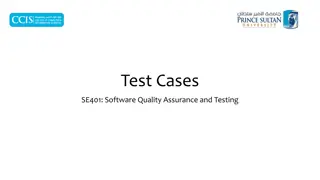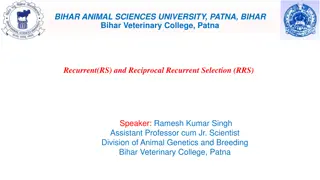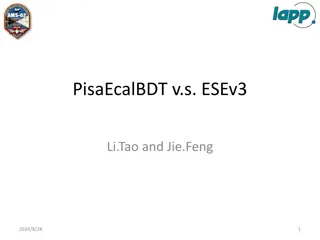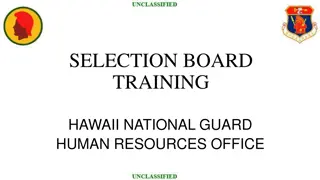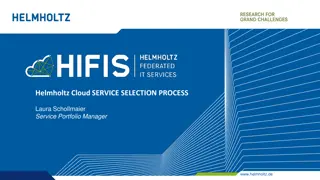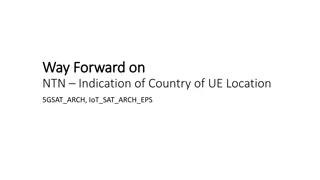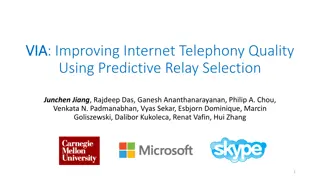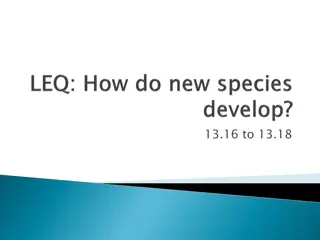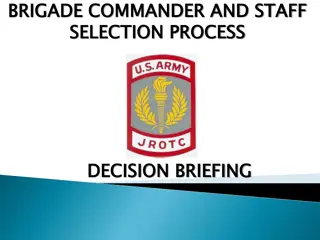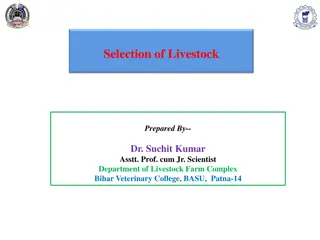Key Issues for PLMN Selection in TR 24.821 CT1 Study
The TR 24.821 CT1 study addresses key issues related to PLMN selection for satellite access, focusing on deployment scenarios, determination of UE location country, PLMN selection in international areas, prioritization of RAT types, and more. The study aims to modify legacy procedures to ensure compatibility with satellite access and resolve potential incompatibility challenges. Detailed discussions on key issues and proposed solutions are essential for successful implementation.
Download Presentation

Please find below an Image/Link to download the presentation.
The content on the website is provided AS IS for your information and personal use only. It may not be sold, licensed, or shared on other websites without obtaining consent from the author.If you encounter any issues during the download, it is possible that the publisher has removed the file from their server.
You are allowed to download the files provided on this website for personal or commercial use, subject to the condition that they are used lawfully. All files are the property of their respective owners.
The content on the website is provided AS IS for your information and personal use only. It may not be sold, licensed, or shared on other websites without obtaining consent from the author.
E N D
Presentation Transcript
Oct 1, 2020 Key issues for TR 24.821 CT1 study item on PLMN selection
Intro CT1 approved a Rel-17 study item on PLMN selection for satellite access the first phase of the WI on stage 3 support for satellite access in C1-205388 Motivation: modify the legacy PLMN selection procedure so that it is compatible with the satellite access. The potential incompatibility issues are listed in the objectives of the WID Only the key issues are discussed here The solutions will be discussed separately after the key issues are agreed Source sample text 2
Key issues for the TR 24.821 Initial list of issues KI#1 Deployment scenarios KI#2: Determination of the country of the UE location KI#3: Selection of a PLMN in the country of the UE location KI#4: PLMN selection in international areas KI#5: PLMN selection for PLMNs with shared/global MCC (9xx) KI#6: Prioritization of new RAT types for PLMN selection KI#7: PLMN search in satellite access Source sample text 3
KI#1: Deployment scenarios Leakage into international waters Cross-border leakage Country A Country C Country B Country A contiguous waters Country A Country C Country A Country B International waters Country D Cross-border leakage A. NTN cell coverage targeting one country or a portion of it (Country A) C. NTN cell coverage targeting one country and its contiguous waters (Country A) B. NTN cell coverage targeting multiple countries (A, B, C) Scenarios B and C can be branched out depending on the MCC of the serving PLMN(s) Scenarios above are not the final set. More scenarios may be added. Source sample text 4
KI#2: Determination of the country of the UE location In the legacy procedure, the UE needs to know the MCC of the serving PLMN Needed during PLMN re-selection when roaming, so the UE can restrict search for higher priority PLMN(s) to those with the same MCC Determination of the country of the UE location is a new LI requirement UE also needs to determine when it is in international areas (no country) For PLMN selection for satellite access, the UE must always first determine its For PLMN selection for satellite access, the UE must always first determine its country country MCC-based location/country determination does not work for NTN because: A radio cell may span multiple countries by design There are PLMN IDs with MCC = 9xx In international areas, the UE can not rely on MCC Source sample text 5
KI#3: Selection of a PLMN in the country of the UE location Applicable when the UE is inside a country (not in international areas) SA3-LI requirement: Any solution shall support the ability to enforce the use of a Core Network of PLMN in the country where the UE is physically located Based on this, selected PLMN must always be in the country of the UE location Does not apply when the UE is in international areas The condition that the selected PLMN must have a CN in the country where the UE is located may be impossible to satisfy during PLMN selection We may need to assume that PLMNs that are allowed based on SIB and USIM configuration and are in the same country as the UE can be selected The CN location verification can take place during registration procedure (by AS or NAS) Source sample text 6
KI#4: PLMN selection in international areas SA3-LI requirement: Any solution addressing extraterritorial (e.g. international maritime zone and aeronautical) use cases should provide means to notify the HPLMN on roaming in and out of those areas Current PLMN selection procedure does not support international areas In current deployments, the coverage on board ships and airplanes is provided by on-board RAN, which is, strictly speaking, in the territory of the country owning the vessel The SA3 The SA3- -LI requirement to select PLMN in the same country does not apply to LI requirement to select PLMN in the same country does not apply to international areas international areas Source sample text 7
KI#5: Handling of PLMNs with shared/global MCC (901) 9xx MCC values are not associated with a country PLMN IDs with global/shared MCC 9xx are typically used by satellite networks MCC 9xx does not correspond to any country Current PLMN selection procedure does not support re-selection to a PLMN with MCC 9xx The UE always searches for higher priority PLMN with the same MCC as the selected VPLMN According to the current procedure, the UE could re-select to/from a global PLMN only from/to another global PLMN Additionally, how to meet LI requirements with MCC 9xx? Source sample text 8
KI#6: Prioritization of RAT types for PLMN selection SA2 has agreed on the following new NTN RAT types: NR(LEO), NR(MEO), NR(GEO) and NR(OTHERSAT) How is RAT prioritization handled for satellite access for UEs supporting both TN and NTN? Use case A: corporate users of a cruise ship company or a trucking company prefer satellite access, allow terrestrial access Use case B: low data rate plans focused on outdoor coverage prefer satellite access, allow terrestrial access Use case C: general public: prefer terrestrial access, allow satellite access Use case D: disaster relief: prefer terrestrial access, allow satellite access with the ability to change the preference (e.g. manually). Source sample text 9
KI#7: PLMN search in satellite access Do we need to adjust the interval of the periodic search for higher priority PLMN for satellite access for roaming UE? Currently, the search interval is between 6 minutes and 8 hours (default 60 minutes) with a configurable parameter MinimumPeriodicSearchTimer Should there be a separate search interval and the MinimumPeriodicSearchTimer parameter for satellite access? Like there is for NB-IoT UE Source sample text 10
